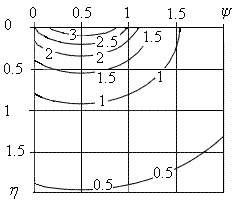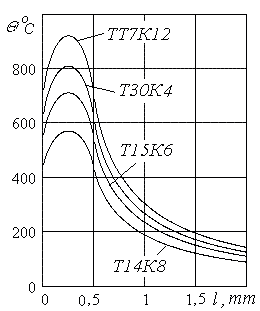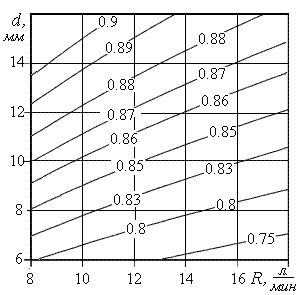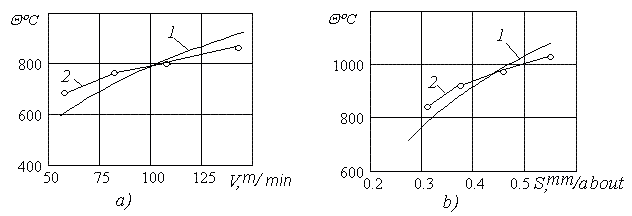1 Introduction
1.1 The substantiation urgency of the problem
The thermal processes at cutting largely determine operation of
technological systems of a machining, rendering essential influencing on function ability of a cutting tool
and quality of processing of parts. The control of thermal processes at cutting is one of reserves of growth
of efficiency of exploitation of a cutting tool, providing increase of its reliability, productivity and
quality of processing.
The application is lubricating - refrigerating of technological mediums is
the most effective way of control of thermal phenomena ensuring a decrease of temperature of cutting, raising
the productivity and qualities of a machining.
The idealized vehicle for research of heat convection characterized by a
heat-transfer coefficient is now detailed enough [1]. However guidelines at the choice of a heat-transfer
coefficient for members of technological systems practically miss. The available items of information on
legitimacies of its change depending on conditions of processing do not contain the information on influencing
a heat-transfer coefficient on temperature of cutting, that does not allow to operating thermal processes at
cutting [2].
Now for cooling of the tool the cutting compounds will predominantly be
used on the basis of aqueous solutions having thermal properties which close to properties of water. At a
machining the most widespread way of refrigerating liquid submission in a cutting zone is the watering by a
freely dropping fluid jet [3]. The practical concern introduces research of influencing of conditions of
refrigerating liquid submission on a heat-transfer coefficient and substantiation of capabilities of its
directional change in given range.
The purpose of the present activity is the complex research of
interconnection of temperature of cutting with conditions of refrigerating liquid submission and heat-transfer
coefficient and also mining on this base of fundamental theory of control of thermal processes at cutting.
1.2 The formulation of the research tasks
The idealized basis of control of cutting temperature in introduced
activity is the analytical description of a thermal condition of the modular cutting tool with mechanical
fastening of the cemented carbide alloy plates of depending on parameters of process of cutting and conditions
of heat convection with environment.
The theoretical investigations of the cutting tool thermal processes are
used for decision of the following tasks:
analytical definition of a temperature field of a tool cutting edge and cutting
temperature;
research of influencing of conditions of refrigerating liquid submission on a
heat-transfer coefficient and substantiation of capabilities of its directional change in given range;
definition of nature and degree of influencing of a heat-transfer coefficient on
cutting temperature.
2 Theoretical researches
2.1 Definition of a temperature field of a tool cutting edge and cutting
temperature
The temperature field of a cutting edge of the tool arising under
operating of a rectangular source of a heat which is operational on a site of a contact of a chip with a
forward surface, is described as follows [1]:

where  - dimensionless coordinates:
- dimensionless coordinates:  =
0,5b/l - dimensionless width of a shear; l - length of bonding contact pad in a direction of
departure of a chip; b - width of a shear; х, y, z – coordinate of points of a cutting edge;
хи, zи – coordinate of a source;
=
0,5b/l - dimensionless width of a shear; l - length of bonding contact pad in a direction of
departure of a chip; b - width of a shear; х, y, z – coordinate of points of a cutting edge;
хи, zи – coordinate of a source;  - thermal
conductivity of a tool stuff; K
- thermal
conductivity of a tool stuff; K - conversion factor from
unlimited space to a unlimited wedge; Т(
- conversion factor from
unlimited space to a unlimited wedge; Т( ,
,
 ,
,  ) - dimensionless temperature field;
P - dimension factor; q - density function of a heat flow.
) - dimensionless temperature field;
P - dimension factor; q - density function of a heat flow.
Dimensionless temperature field in the tool cutting edge is adduced in a
fig. 1.

|
Figure 1 - Dimensionless temperature field in the tool cutting edge. |
|
Temperature of cutting is calculated as follows:

where  - dimensionless expression of wearing on a flank surface h:
- dimensionless expression of wearing on a flank surface h:
 = h/l; ТР - dimensionless temperature of cutting.
= h/l; ТР - dimensionless temperature of cutting.
The graphs of a dimensionless temperature of cutting from dimensionless
expression of wearing on a flank surface  and dimensionless width of a shear
and dimensionless width of a shear
 are adduced in a fig.2.
are adduced in a fig.2.

|
Figure 2 - The graphs of a dimensionless temperature of cutting from dimensionless expression
of wearing on a flank surface  and dimensionless width of a
shear and dimensionless width of a
shear  . . |
|
The graphs of a dimensionless temperature of cutting from
dimensionless expression of wearing on a flank surface  and dimensionless
width of a shear
and dimensionless
width of a shear  in double logarithm scale are adduced in a fig.3.
in double logarithm scale are adduced in a fig.3.

|
Figure 3 - The graphs of a dimensionless cutting temperature from dimensionless expression of
wearing on a flank surface  and dimensionless width of a
shear and dimensionless width of a
shear  in double logarithm scale. in double logarithm scale. |
|
For practical usage the simplified model of calculation of
dimensionless temperature of cutting is offered:

The description of a temperature field
Т( ,
,  ,
,
 ) and temperature of cutting ТР in a dimensionless kind
allows to establish of general regularity of a temperature variation, which one for concrete version of
processing are corrected by a dimension factor
) and temperature of cutting ТР in a dimensionless kind
allows to establish of general regularity of a temperature variation, which one for concrete version of
processing are corrected by a dimension factor  , taking into account
properties of the tool and condition of its operation.
, taking into account
properties of the tool and condition of its operation.
The distribution of temperatures on a forward surface of an edge of
the tool in a plane perpendicular to main cutting list  (x, 0, 0)
from various tool materials is adduced in a fig.4.
(x, 0, 0)
from various tool materials is adduced in a fig.4.

|
Figure 4 - Distribution of temperatures on a forward surface of an edge of cutters with
various cemented carbide alloy plates. |
|
The accounts of temperatures for cutters equipped with of the
cemented carbide alloy plates (Т14К8 -  = 33,9Vt/m
= 33,9Vt/m

 С, Т15К6 -
С, Т15К6 -
 = 27,2Vt/m
= 27,2Vt/m
 С, Т30К4 -
С, Т30К4 -  = 23,9Vt/m
= 23,9Vt/m

 С, ТТ7К12 -
С, ТТ7К12 -
 = 20,9Vt/m
= 20,9Vt/m
 С) are executed for the following conditions: a processable material -
steel 45,
С) are executed for the following conditions: a processable material -
steel 45,  = 750МPа, modes of cutting - depth of cutting t = 2mm,
submission s = 0,4mm/about, speed of cutting v = 120 m/mines., deterioration on a back surface
of an edge h = 0,9mm. Geometrical parameters of cutters: corners in the plan
= 750МPа, modes of cutting - depth of cutting t = 2mm,
submission s = 0,4mm/about, speed of cutting v = 120 m/mines., deterioration on a back surface
of an edge h = 0,9mm. Geometrical parameters of cutters: corners in the plan
 =
=  1 = 45°, forward corner
1 = 45°, forward corner
 = -5°, back corner
= -5°, back corner  = 5°. For this conditions:
l = 0,45mm, q = 2,37
= 5°. For this conditions:
l = 0,45mm, q = 2,37 10
10 Vт
/m
Vт
/m .
.
The results of accounts of temperatures on a forward surface of an
edge for cutters from various tool materials testify to significant distinction of temperatures depending on
properties of a tool material and cutting conditions.
Maximal temperature takes place at meanings
 = 0,5;
= 0,5;  = 0 and is calculated as
follows:
= 0 and is calculated as
follows:

Maximal temperature determines necessity of usage is lubricating -
refrigerating technological mediums.
2.2 Research of influencing of conditions of refrigerating liquid
submission on a heat-transfer coefficient
The second stage is the research of influencing of conditions of
refrigerating liquid submission on a heat-transfer coefficient for the most widespread ways of its submission
in a cutting zone - the free watering, pressure head spray and sputtering.
At refrigerating liquid submission in a cutting zone the free watering for
definition of a heat-transfer coefficient a will use a criteria equation [1]:

where  - dimensionless yardsticks Nusselt, Reynolds and Prandtl accordingly;
l - reference size;
- dimensionless yardsticks Nusselt, Reynolds and Prandtl accordingly;
l - reference size;  0 - thermal conductivity of a
liquid; w - flow velocity;
0 - thermal conductivity of a
liquid; w - flow velocity;  - cinematic coefficient
of viscosity of medium;
- cinematic coefficient
of viscosity of medium;  - thermal diffusivity.
- thermal diffusivity.
The heat-transfer coefficient instituted from this equation for the
refrigerating liquid on the basis of aqueous solutions (3 % - 5 % of pap) looks like:

where l = BH/2(B+H) - instituted under condition of cross-sectional flow around a body by a liquid;
B, Н - sizes of the tool.
With allowance for that the flow velocity of a liquid w =
4 103R/60
103R/60 d2 is
determined by its consumption R and diameter of a nozzle d she follows from which one the
heat-transfer coefficient is peer:
d2 is
determined by its consumption R and diameter of a nozzle d she follows from which one the
heat-transfer coefficient is peer:

At refrigerating liquid submission in a cutting zone the pressure
head spray for definition of a heat-transfer coefficient a will use a criteria equation:

The heat-transfer coefficient instituted from this equation looks
like:

where reference size l = Н.
With allowance at the flow velocity of a liquid the heat-transfer
coefficient is peer:

At refrigerating liquid submission in a cutting zone sputtering the
heat-transfer coefficient is peer:

where K – concentration liquid in diphase air - liquid medium,
m = 6,  a - the heat-transfer coefficient in air:
a - the heat-transfer coefficient in air:

2.3 Definition of nature and degree of influencing of a heat-transfer
coefficient on temperature of cutting
Following stage is the definition of nature and degree of influencing of a
heat-transfer coefficient on temperature of cutting.
As a result of researches for the most widespread ways refrigerating
liquid submission in a cutting zone justifies following interconnection of a factor of a decrease of
temperature of cutting КQ with a heat-transfer coefficient:
the sputtering

the pressure head spray

the free watering

At refrigerating liquid submission the free watering with allowance (7)
factors of a decrease of temperature of cutting КQw is peer:

The obtained expression allows forecasting a level of a decrease of
temperature of cutting depending on conditions of refrigerating liquid submission in a cutting zone.
The graphs of a factor of a decrease of temperature of cutting
КQw (by the way of level lines, on which one in digits are indicated its values) from the
consumption R of a liquid and diameter of a nozzle d for ВхН = 20х25mm2 are
adduced in a fig. 5.

|
Figure 5 - The graphs of a factor of a decrease of cutting temperature КQw
from the consumption R of a liquid and diameter of a nozzle d. |
|
It is ground of the introduced schedules for a set value of this
factor КQw the conditions of refrigerating liquid submission ensuring demanded temperature
at cutting are established.
3 Experimental researches
The experimental investigations of the cutting temperatures are used for
the substantiation adequation theoretical models.
The experimental researches and accounts of temperatures for cutters from
other tool materials are executed for the following conditions: a processable material - steel 45, modes of
cutting - depth of cutting t = 1мм, submission s = 0,1мм/about, speed of cutting v =
120 м/mines., deterioration on a back surface of an edge h = 0,4мм.
The modular cutting tool with mechanical fastening of the cemented carbide
alloy plates T15K6 had geometrical parameters of cutters: corners in the plan
 =
=  1 = 45°, forward corner
1 = 45°, forward corner
 = -5°, back corner
= -5°, back corner  = 5°.
= 5°.

|
Figure 6 - The theoretical and experimental graphs of a temperature of cutting from speed of
cutting v – a) and submission s – b). |
|
The experimental parameters (graphs 2) well enough coincide with
idealized theoretical (graphs 1). Parameters for theoretical modes distinguished from experimental here are
submitted on 10 % what are corroborated adequation theoretical models.
4 Conclusions
The developed technique of the analytical definition of a temperature
field of a tool cutting edge and cutting temperature are permitting to regulate a given level of temperature
at the expense of selection of rational conditions of processing and to determine necessity of usage is
lubricating - refrigerating technological mediums.
The developed technique is applicable for definition of temperature fields
of various tools. Established on an example of the cutters the laws of influence of geometrical parameters on
distribution of temperatures on a forward surface of an edge can be distributed on any tools. The features of
various kinds of processing are taken at account of density of a thermal flow and length of contact of a
shaving with a forward surface of an edge. On the basis of the received results the recommendations at the
choice of a tool material and rational parameters of the tool are developed.
For the most widespread ways of submission of the refrigerating liquid in
a cutting zone - the free watering, pressure head spray and sputtering regulates main conditions of
refrigerating liquid submission - consumption and speed ensuring any given heat-transfer coefficient.
As a result of researches the interconnection of a factor of a decrease of
cutting temperature with a heat-transfer coefficient is justified at different ways of refrigerating liquid
submission in a cutting zone, that allows to supply any given level of temperature of cutting at the expense
of selection of the conforming heat-transfer coefficient and conditions of refrigerating liquid
submission.
The designed technique utilized for the analysis of temperature of cutting
at fair and thin turning processing by chisels equipped hard alloys. With allowance for of established
temperature limitations, the method of a linear programming determines optimum regimes of fair and thin
turning processing ensuring maximum productivity. Is justified that a decrease of temperature of cutting and
removal of temperature limitation for the score the application of the refrigerating liquid with the regulated
conditions of its submission in a cutting zone provides a raising the productivity of processing in 1,5 - 3
times.
Thus as a result of the conducted complex researches the interconnection
of cutting temperature with conditions of refrigerating liquid submission and heat-transfer coefficient are
established on the basis of which one the fundamental theory of control of thermal processes are designed at
cutting.
References
Резников А.Н., Резников Л.А. Тепловые процессы в технологических системах. - М.:
Машиностроение, 1990. – 288с.
Iвченко Т.Г. Аналітичне визначення температури різання в залежності від умов
експлуатації ріжучого інструменту // Наукові праці Донецького національного технічного університету.
Серія: Машинобудування і машинознавство. Випуск 92. - Донецьк, ДонНТУ, 2005.- С.37-42.
Івченко Т.Г., Нечепаєв В.Г., Гнитько, О.М. Вплив способу подачі охолоджуючого
середовища на температуру різання // Надійність інструменту та оптимізація технологічних систем.
Збірник наукових праць. Вип. 16 . – Краматорськ: ДДМА, 2005. - с.34 - 38.
Электронная библиотека

 - dimensionless coordinates:
- dimensionless coordinates:  =
0,5b/l - dimensionless width of a shear; l - length of bonding contact pad in a direction of
departure of a chip; b - width of a shear; х, y, z – coordinate of points of a cutting edge;
хи, zи – coordinate of a source;
=
0,5b/l - dimensionless width of a shear; l - length of bonding contact pad in a direction of
departure of a chip; b - width of a shear; х, y, z – coordinate of points of a cutting edge;
хи, zи – coordinate of a source;  - thermal
conductivity of a tool stuff; K
- thermal
conductivity of a tool stuff; K - conversion factor from
unlimited space to a unlimited wedge; Т(
- conversion factor from
unlimited space to a unlimited wedge; Т( ,
,
 ,
,  ) - dimensionless temperature field;
P - dimension factor; q - density function of a heat flow.
) - dimensionless temperature field;
P - dimension factor; q - density function of a heat flow.

 - dimensionless expression of wearing on a flank surface h:
- dimensionless expression of wearing on a flank surface h:
 = h/l; ТР - dimensionless temperature of cutting.
= h/l; ТР - dimensionless temperature of cutting. and dimensionless width of a shear
and dimensionless width of a shear
 are adduced in a fig.2.
are adduced in a fig.2.
 and dimensionless width of a
shear
and dimensionless width of a
shear  .
. and dimensionless
width of a shear
and dimensionless
width of a shear  in double logarithm scale are adduced in a fig.3.
in double logarithm scale are adduced in a fig.3.
 and dimensionless width of a
shear
and dimensionless width of a
shear  in double logarithm scale.
in double logarithm scale.
 ,
,  ,
,
 ) and temperature of cutting ТР in a dimensionless kind
allows to establish of general regularity of a temperature variation, which one for concrete version of
processing are corrected by a dimension factor
) and temperature of cutting ТР in a dimensionless kind
allows to establish of general regularity of a temperature variation, which one for concrete version of
processing are corrected by a dimension factor  , taking into account
properties of the tool and condition of its operation.
, taking into account
properties of the tool and condition of its operation. (x, 0, 0)
from various tool materials is adduced in a fig.4.
(x, 0, 0)
from various tool materials is adduced in a fig.4.
 = 33,9Vt/m
= 33,9Vt/m

 С, Т15К6 -
С, Т15К6 -
 = 27,2Vt/m
= 27,2Vt/m
 С, Т30К4 -
С, Т30К4 -  = 23,9Vt/m
= 23,9Vt/m

 С, ТТ7К12 -
С, ТТ7К12 -
 = 20,9Vt/m
= 20,9Vt/m
 С) are executed for the following conditions: a processable material -
steel 45,
С) are executed for the following conditions: a processable material -
steel 45,  = 750МPа, modes of cutting - depth of cutting t = 2mm,
submission s = 0,4mm/about, speed of cutting v = 120 m/mines., deterioration on a back surface
of an edge h = 0,9mm. Geometrical parameters of cutters: corners in the plan
= 750МPа, modes of cutting - depth of cutting t = 2mm,
submission s = 0,4mm/about, speed of cutting v = 120 m/mines., deterioration on a back surface
of an edge h = 0,9mm. Geometrical parameters of cutters: corners in the plan
 =
=  1 = 45°, forward corner
1 = 45°, forward corner
 = -5°, back corner
= -5°, back corner  = 5°. For this conditions:
l = 0,45mm, q = 2,37
= 5°. For this conditions:
l = 0,45mm, q = 2,37 10
10 Vт
/m
Vт
/m .
. = 0,5;
= 0,5;  = 0 and is calculated as
follows:
= 0 and is calculated as
follows:

 - dimensionless yardsticks Nusselt, Reynolds and Prandtl accordingly;
l - reference size;
- dimensionless yardsticks Nusselt, Reynolds and Prandtl accordingly;
l - reference size;  0 - thermal conductivity of a
liquid; w - flow velocity;
0 - thermal conductivity of a
liquid; w - flow velocity;  - cinematic coefficient
of viscosity of medium;
- cinematic coefficient
of viscosity of medium;  - thermal diffusivity.
- thermal diffusivity.
 103R/60
103R/60 d2 is
determined by its consumption R and diameter of a nozzle d she follows from which one the
heat-transfer coefficient is peer:
d2 is
determined by its consumption R and diameter of a nozzle d she follows from which one the
heat-transfer coefficient is peer:




 a - the heat-transfer coefficient in air:
a - the heat-transfer coefficient in air:






